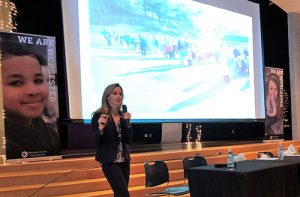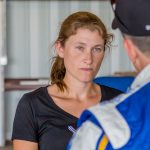
NEWARK – “To this day I can still count out the rhythm of that gunfire.”
Nearly 20 years after the attack at Columbine High School, teacher Kiki Leyba recounted the horror of that day to local educators at a school safety conference this week. The event, The Maryland Initiative 2018: Recovering the School Community from Crisis, was presented by the Maryland Center for School Safety, Safe and Sound Schools, the BFG Foundation and Worcester County Public Schools.
“I don’t think there’s an easy fix but together we’re going to make a difference,” Superintendent Lou Taylor told the crowd of attendees at Worcester Technical High School.
School system administrators and law enforcement personnel from Worcester, Wicomico, Somerset and Dorchester counties gathered at the school Tuesday to hear from a variety of speakers impacted by tragedies at schools.
“It’s important that we all are here together because we don’t have this quite figured out yet,” said Ed Clarke, executive director of the Maryland Center for School Safety.
Michele Gay, co-founder and executive director of Safe and Sound Schools, shared her experience following the shooting at Sandy Hook Elementary School in 2012. Her youngest daughter Josephine, a first-grader, was among those killed that day.
“I share these details with you because I want you to know what really happened,” she said.
Gay described the way she’d dropped her daughter off at school that morning only to receive a phone call shortly after returning home advising parents that schools were on lockdown because of a shooting.
“The first images that popped into my head were those of Columbine,” she said.
Wanting to be sure her children were safe, she headed for the elementary school. When she saw kids evacuating to the fire house near the school, she thought that was a good sign, particularly when she quickly located her daughter who was in fourth grade.
While the kids were familiar with the evacuation routine, Gay recalled how quickly the scene turned to chaos as 26 law enforcement agencies and countless other people arrived.
“I didn’t even know there’d been an attack at this point,” she said.
Gay wasn’t able to locate the school’s administrators or her youngest daughter. She’d eventually find out that the principal and several staff members had been killed, along with her daughter and 19 other children.
Gay said that while the school had done lockdown drills, the procedures they practiced, such as locking classroom doors, didn’t work in an actual emergency. She said there hadn’t been time for teachers to retrieve classroom keys from the folders they’d been kept in and lock their doors from the outside.
“This worked wonderfully when we practiced,” she said. “It didn’t work on this day. It happened way too fast.”
Some children were able to run past the gunman and get out of the building. When they arrived at the firehouse, the location they’d been trained to evacuate to, it was some time before they found someone to let them into the building.
“We hadn’t planned for how an emergency might really unfold,” Gay said.
Gay said another thing the community realized following the Sandy Hook tragedy was teachers were the ones tasked with taking charge of the situation until law enforcement arrived.
“When crisis begins to unfold you are thrust into an unfamiliar and unwitting role as first responder,” she said. “Until the cavalry arrives you’re it.”
Gay stressed that planning and preparing for emergencies was critical. So many communities, she says, believe tragedies like school shootings just won’t happen to them. She said that while the Sandy Hook Elementary School community had drills and practiced evacuating, they never truly believed they’d need to.
“It’s important for us to think about this ‘not here’ plan and make sure it’s not the plan in our schools,” she said.
Gay also described the recovery process following the Sandy Hook shooting. She said even mental health needed to be considered in advance of a tragedy. While counselors and therapists tried to come to Sandy Hook in the hours after the shooting, many of them weren’t even able to connect with those in need of their help because of the crowds of people present. She encouraged listeners to think about who would provide them with emotional support in event of a tragedy.
“Every one of you is somebody else’s support system,” she said. “It’s critical you have a support system.”
Other things — donations, memorials, and even lawsuits — can cause unforeseen strife following a tragedy.
“They are a reality and it’s important for us to understand those and think about those ahead of time,” she said.
While Gay offered a parent’s point of view, speaker Lisa Hamp provided conference attendees with a different perspective. Hamp was in a computer science class at Virginia Tech in 2007 when Seung-Hui Cho, a senior at the school, locked the building’s doors and began shooting at the people inside. She described the way the students in her classroom barricaded the door to prevent the shooter from entering. She spoke in depth about the emotional struggles she experienced after the shooting, which left 32 people dead. She talked about her anxiety, her nightmares and her obsession with exercise. She said everyone impacted by a horrific event could react differently.
“Our experiences are not meant to be compared,” Hamp said. “Our needs are going to vary.”
She said it was easy to forget that victims weren’t the only ones affected by tragedies, as emergency responders were impacted too.
“After these events there are so many invisible scars…,” she said. “What I thought about April 16, 2007, is I thought it was the end when I walked out. When that gunfire ended. What I didn’t realize was that those 11 minutes was just the beginning of a long recovery.”
Leyba offered yet another perspective, as he was in his first year of teaching English at Columbine High School in 1999 when two students attacked the school. He was in a meeting with the school’s principal when a report of shots fired came over the radio. In the chaos that ensued, Leyba eventually found himself outside talking to one of the first police officers to arrive. He was dumbfounded to be asked to draw the officer a map of the school as the violence continued.
“He didn’t have plans for our school,” Leyba said.
Like Gay and Hamp, Leyba talked extensively about the recovery process the community went through after the tragedy. He said he and his peers felt helpless as they went from one memorial to another in the days and weeks following the shooting. When classes resumed — in a nearby high school — the grief continued.
“We had no business being in front of those kids … we were all so damaged,” he said, adding that no one was able to focus on things like test scores. “It became so clear to most of us that those things didn’t matter.”
Leyba said the shooting also thrust the school into the national spotlight. Much of the attack had even been broadcast on television.
“The media began to propagate stories and myths about the jock culture of our school, bullying,” Leyba said. “I think still when we have these tragedies unfold the things you can expect to hear right away are ‘we never thought it would happen here’ and ‘were they bullied.’ That was a sexy story for the media to run with. It really painted an awful picture of our school and our staff. Many of us resented that.”
He said he struggled for several years until he connected with the right counselor, one who was able to help him.
“The road back, it was hell,” he said.
Leyba, who still teaches at Columbine, said in recent years he and several of his peers have visited other schools that have been impacted by violence. They talk with the teachers and share their own experiences.
“It’s strange work but it feels really important to stand before them and be honest …,” he said, adding that attention to mental health was critical following an event like Columbine. “I feel so passionate about this work because I don’t want people to go through what we did.”
Leyba wasn’t the only speaker Tuesday who was familiar with the Columbine tragedy. John MacDonald, executive director of safety, security and emergency planning for Jefferson County Schools in Colorado, told the crowd he’d been in law enforcement since 1989 but decided to focus on school safety following the 1999 shooting. He said there had been seven school shootings in Colorado since Columbine.
“I see too many people who still don’t believe it’ll happen,” he said.
MacDonald said events like the conference were vital in ensuring jurisdictions that did experience tragedies were better prepared to handle them. He said school systems could learn from the experiences of others.
“The real lessons learned are the mistakes you’ve made, the things we didn’t think about,” he said, adding that law enforcement and educators would be learning from the recent Parkland tragedy. “We’re going to be learning lessons from their tragedy for years to come, just like we do from all of the tragedies and school violence. If we fail to do that we’re destined to continue to have these issues.”
MacDonald said that while school security across the country had improved in recent years, there were still too many people “wanting to put their head in the sand.” He said members of the school community had to be willing to act. He said threats should be taken seriously.
“Never justify it…,” he said. “Believe the threat until you know otherwise. If a student’s writing a hit list, if a student’s engaging in inappropriate behavior in school, making a threat to kill, you believe that student. Can we do otherwise with all the school shootings we’re experiencing around the country?”

